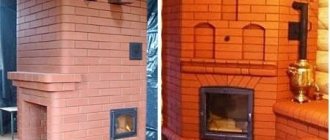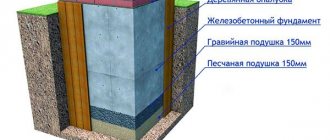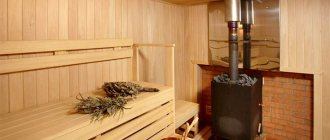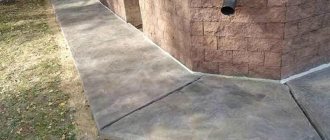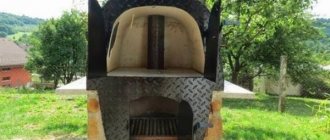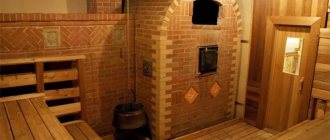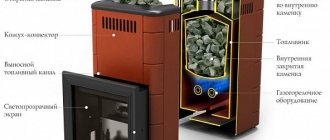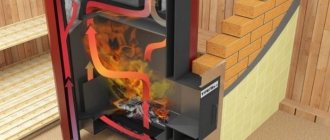- Posted by Ksenia Zubkova
- Date: May 19, 2017
The jet stove or rocket stove appeared as a result of a deviation from the traditions of manufacturing equipment for heating a room. It is considered an economical heat generator, the design of which is elementary. Therefore, many people are thinking about building a jet furnace with their own hands.
- 2 Types
- 3 Parts and operation of the jet heat generator
- 4 Calculation of parameters (tables)
- 5 Construction raw materials for the construction of a non-standard furnace
- 6 Preparation for assembling heating equipment
- 7 Step-by-step instructions for making it yourself
- 8 Design improvements
- 9 Subtleties of operating an unconventional stove
What is a rocket stove and why is it good?
The rocket stove or jet stove received its impressive names only for the characteristic sound that it makes when the operating mode is violated (excessive air supply to the firebox): it resembles the roar of a jet engine. That's all, it has nothing more in common with rockets. It works, if you don’t go into details, the same way as all its sisters: wood burns in the firebox, smoke is thrown out into the chimney. Normally, the oven makes a quiet rustling sound.
Reaction furnace arrangement option
Where do these mysterious sounds come from? Let's talk about everything in order. Here's what you should know about the rocket stove:
- By purpose it is a heating and cooking unit.
- “Rocket” can be equipped with such an important and necessary element as a bed. Other types of stoves with this option (Russian, bell-type) are much more bulky and complex.
- Compared to conventional metal stoves, the operating time on one load of fuel has been slightly increased - from 4 to 6 hours. This is explained by the fact that this heat generator is based on a top-combustion furnace. In addition, thanks to the presence of adobe plaster, the stove gives off heat for another 12 hours after firing.
- The furnace was developed for use in field conditions.
Design advantages
- Energy independence.
- Simplicity of design: the most available parts and materials are used; if necessary, a simplified version of the rocket stove can be assembled in 20 minutes.
- Ability to work with sufficiently high performance on low-quality raw fuel: bark, wood chips, thin raw branches, etc.
The operating principle of the rocket stove provides the user with a certain freedom in choosing its design. In addition, the unit can be constructed in such a way that only a small part of it will remain visible and, in terms of aesthetics, minimal damage will be caused to the interior of the room.
Jet stove with stove bench
As you can see, the jet stove has something to brag about. But first of all, stove lovers are attracted by the combination of simplicity of design and good, although not the highest, characteristics when working on waste fuel. These very characteristics are the highlight of the “rocket”. Let's try to understand how we managed to achieve such indicators.
The efficiency of a solid fuel heat generator depends on many factors, but perhaps the most determining factor is the degree of afterburning of pyrolysis gases. They appear due to the thermal decomposition of organic fuel. When heated, it seems to evaporate - large hydrocarbon molecules break up into small ones that form flammable gaseous substances: hydrogen, methane, nitrogen, etc. This mixture is often called wood gas.
Small rocket stove
Liquid fuel, for example, waste oil, breaks down into wood gas almost immediately and it burns right there - in the firebox. But with wood fuel the situation is different. The decomposition of solids into a volatile product suitable for combustion - wood gas - occurs in several stages, with intermediate stages also having a gaseous form. That is, we have the following picture: first, a certain intermediate gas is released from the wood, and in order for it to turn into wood gas, that is, to disintegrate even more, it is necessary to prolong its exposure to high temperature.
And the more humid the fuel is, the more “prolonged” the process of complete disintegration becomes. But gases tend to evaporate: in a conventional furnace, the intermediate phase is mostly sucked out by draft into the chimney, where it cools down without having time to turn into wood gas. As a result, instead of high efficiency, we get soot from heavy hydrocarbon radicals.
In a rocket furnace, on the contrary, all conditions are created for the final disintegration and afterburning of the released intermediate gases. In essence, a very simple technique was used: immediately behind the firebox there is a horizontal channel with good thermal insulation. The gases in it do not move as quickly as in a vertical pipe, and the thick heat-insulating coat does not allow them to cool. Thanks to this, the process of decomposition and afterburning is carried out more fully.
At first glance, this solution may seem primitive. But this simplicity is deceptive. Engineers and researchers had to tinker a lot with calculations in order to link the required thrust force with the optimal combustion mode and many other factors. Thus, a rocket stove is a very finely tuned thermal system, when reproducing it it is very important to maintain the correct ratio of the main parameters.
If the manufacture and adjustment of the unit were carried out correctly, the gases will move as expected, while emitting a slight rustling sound; if the regime is violated or the furnace is assembled incorrectly, instead of a stable gas vortex in the gas duct, an unstable one is formed, with numerous local vortices, as a result of which a roaring rocket sound will be heard.
Flaws
- The reaction furnace is manually controlled, and the user constantly has to monitor and adjust it.
- The surface of some elements heats up to high temperatures, so that if accidentally touched, the user may get burned.
- The scope is somewhat limited. For example, a jet stove cannot be used in a bathhouse, since it is not able to quickly warm up the room.
One more circumstance should be taken into account. It cannot be considered a disadvantage of the stove; rather, it is an important feature. The fact is that the “rocket” was invented in the USA. And the citizens of this country, where any idea can bring good money, are not as willing to share their work as was customary, for example, in the Soviet Union. Most of the drawings and diagrams that have become widespread do not display or distort the most important information. In addition, we simply do not have access to some of the materials used in it.
As a result, home craftsmen, especially those who do not know the intricacies of stove making and heating engineering, often end up with a device that absorbs fuel in huge volumes and is constantly overgrown with soot instead of a full-fledged jet stove. Thus, complete information about the rocket stove has not yet become public property and overseas pictures should be treated with great caution.
Here, for example, is our popular jet furnace design, which many are trying to use as a model.
Drawing: how the stove works
Drawing of a mobile rocket oven
At first glance, everything seems clear, but in fact, much remains “behind the scenes.”
For example, refractory clay is simply designated by the term Fire Clay - without specifying the grade. The mass ratio of perlite and vermiculite in the mixture from which the body of the furnace (in the diagram - Core) and the lining of the element called Riser is not indicated. Also, the diagram does not specify that the lining should consist of two parts with different functions - a heat insulator and a heat accumulator. Without knowing this, many users make the lining homogeneous, which is why the performance of the furnace drops significantly.
Types of jet heating devices. Choosing a design for self-production
Craftsmen have developed several designs of rocket stoves suitable for mobile or stationary use:
- portable units made of metal pipes, cans or buckets;
- jet heating devices from a gas cylinder;
- ovens built from fireclay bricks and metal containers;
- heating heat generators with a stove bench.
The most difficult to manufacture are the structures, the construction of which requires the skills of a mason. However, if you have detailed diagrams of serial layouts, even a novice home craftsman can handle this work.
Portable rocket stove
Portable rocket stoves are mass-produced by industry
Hiking options are represented by the simplest designs, which are based on the same pipe bent or welded from individual sections. The improvements affected only the installation of a partition for arranging the ash pit, in which a slot is made for air leakage. Often the lower part of the loading chamber is equipped with a grate to supply air directly to the combustion zone. The opening for storing firewood is equipped with a door, which subsequently regulates the air supply.
The requirements for a mobile design also extend to convenience during cooking, so the upper section of the chimney must be equipped with a stand for metal utensils.
Gas cylinder unit
The use of a gas cylinder is the next step in the development of jet heating devices. A more complex design can significantly increase the thermal power and efficiency of the furnace. All that is required to make the installation is a household gas cylinder or fuel barrel, sections of thick-walled steel pipes and a metal sheet 3–5 mm thick.
A rocket stove made from a gas cylinder can be used to heat small utility rooms
If you have a piece of steel pipe with thick walls and a diameter of more than 30 cm, a rocket stove can be made from it. This option will allow you to avoid labor-intensive operations associated with disassembling the factory gas tank.
How such a design works can be seen in the diagram below. Firewood loaded into the firebox burns due to the flow of air through the loading window. Afterburning of combustible gases occurs in a pipe installed inside the cylinder due to the supply of secondary air. To enhance the effect, the inner chamber is insulated, which makes it possible to raise the temperature inside above 1000 °C. Hot gases hit the bell as they move and enter the outer chamber, the walls of which act as a heat exchanger. Having given up their energy, the combustion products are discharged through a chimney cut into the lower part on the back side of the cylinder.
To create the draft necessary for stable operation of the rocket stove, the top of the chimney is raised at least 4 m relative to the loading window.
Combined rocket stove made of brick and metal barrel
The use of fireclay bricks for arranging the firebox and internal chambers of a jet heating device transforms the “rocket” into the category of stationary structures. The high heat capacity of the materials used allows heat to be accumulated and released within several hours, which is why such units are often installed in residential premises.
Furnace structure with refractory lining of the working area
Jet stove with stove bench
Like other solid fuel stoves, the "rocket" has the disadvantage that most of the heat is lost through the chimney. Despite this, certain advantages of its design make it easy to get rid of this disadvantage. The thing is that the unit was called reactive for a reason, but because of the high rate of excision of burning gases. This feature can be turned into a benefit by significantly increasing the length of the smoke exhaust channels.
Scheme of a jet stove with a stove bench
This idea found its implementation in massive stationary structures with a couch in the shape of a sofa or bed. It is successfully made from brick or rubble stone, decorated with a plastic mass of clay and sawdust. Thanks to the high heat capacity of the materials used, the stove can retain heat all night, which, combined with high efficiency, makes the heating unit very attractive for installation in residential premises.
When choosing a design for manufacturing at home, you need to take into account the features of its operation. As a camping option, choose a mobile unit - it will be enough to warm up, dry clothes and cook lunch. In order to occasionally heat small technical rooms, a portable structure made from a gas cylinder is used. If you need to heat a small country house or cottage, then there is simply no better option than a jet heating unit with a stove bench.
Types of jet furnaces
Today there are only two types of furnaces of this type:
- A full-fledged stationary heating and cooking rocket stove (also called a large one).
- Small rocket stove: used for cooking in the warm season. Unlike the first option, it is portable and has an open firebox (intended for use outdoors). It is very popular among tourists, as it has a compact size and is capable of developing power up to 8 kW.
Design of a small rocket stove
As already mentioned, a jet stove is easy to manufacture, so we will consider a full-fledged option.
Parts and operation of a jet heat generator
A basic rocket furnace is a device consisting of two pipe fragments connected by a bend at an angle of 90 degrees. The combustion chamber in this heat generator is usually a zone in the horizontal part of the structure. But sometimes fuel is placed in the vertical section of the apparatus, for which a rocket stove is constructed from two pipes of different lengths, mounted vertically and connected by a common horizontal channel.
Primary and secondary air passes through the furnace
The operation of a jet stove is based on two actions: the unhindered passage of wood gases through the pipe and the afterburning of gases produced during fuel combustion. Wood chips and firewood are placed in the firebox of this heat generator after a highly flammable material such as paper ignites. A container with water or other contents is placed on the open section of the pipe. At the same time, a small space is left between the structure and the installed container, which is necessary to create traction.
The processes occurring inside a stationary reactive furnace resemble the operation of pyrolysis heating units
Design and principle of operation
The stove we will try to make is shown in the picture.
Rocket stove: frontal section
As you can see, its combustion chamber (Fuel Magazine) is vertical and is equipped with a tightly closing lid (prevents the leakage of excess air), as in a top-burning stove (the ash pit is designated the Primary Ash Pit). It was this unit that was taken as the basis. But a traditional top-burning heat generator operates only on dry fuel, and the creators of the “rocket” wanted to teach it to successfully digest wet fuel. To do this, the following was done:
- The optimal size of the blower (Air Intake) was selected so that the amount of incoming air was sufficient to burn the gases, but at the same time they did not cool too much. In this case, the principle of top combustion provides some kind of self-regulation: if the fire gets too hot, it becomes an obstacle to the incoming air.
- A well-insulated horizontal channel was installed behind the firebox, called the Burn Tunnel or flame tube. To hide the purpose of this element, it was marked on the diagram with a meaningless flame icon. Thermal insulation (Insulation) must have not only low thermal conductivity, but also low heat capacity - all thermal energy must remain in the gas flow. In the flame tube, the intermediate gas breaks down into wood gas (at the beginning of the section), which then burns completely (at the end). In this case, the temperature in the pipe reaches 1000 degrees.
- Behind the fire tube was a vertical section called the Internal or Primary Vent. In diagrams, secretive Americans often designate this element with the meaningless term Riser. In fact, the primary chimney is a continuation of the fire tube, but it was placed vertically to create an intermediate draft, and at the same time reduce the horizontal part of the furnace. Like the fire tube, the primary chimney has a heat-insulating coating.
Note. Some readers familiar with the design of pyrolysis furnaces may think that it would be a good idea to supply secondary air to the base of the primary chimney. Indeed, the combustion of wood gas would be more complete, and the efficiency of the stove would be higher. But with this solution, vortices are formed in the gas flow, as a result of which toxic combustion products partially penetrate into the room.
Next, the engineers were faced with the task of removing the heat from hot gases having a temperature of about 900 degrees.
A capacious heat accumulator capable of withstanding such temperatures is fireclay brick (withstands up to 1600 degrees), but the stove, as the reader remembers, was intended for field conditions, so a more accessible and inexpensive material was needed. The leader in this regard is adobe (denoted in the diagram by the term Thermal Mass), but its temperature limit is 250 degrees. To cool the gases, a thin-walled steel drum (Steel Drum) was installed around the primary chimney, in which they expand. You can cook food on the cover of this drum (Optional Cooking Surface) - its temperature is about 400 degrees.
To absorb even more heat, a horizontal chimney with a stove bench (Airtight Duct) was attached to the stove, and only then an external chimney (Exhaust Vent). The latter was equipped with a view that closes after heating: it will not allow the heat from the gas duct of the stove to evaporate into the street.
So that the pipe inside the stove could be cleaned from time to time, a secondary ash chamber (Secondary Airtight Ash Pit) with a hermetically sealed cleaning door was installed immediately behind the drum. The main part of the carbon deposits, due to the sharp expansion and cooling of gases, settles in it, so cleaning the external chimney has to be done extremely rarely.
Since the secondary ash chamber has to be opened no more than twice a year, instead of a door, a simpler design can be used - a screw-on lid with a gasket made of asbestos or basalt cardboard.
Features of the structure
To make a jet stove with your own hands, you do not need to have any special skills. Due to its compactness and ease of execution, it can be made in a few hours.
The basis of the design is two vertical chambers of different sizes, connected at the bottom by a common channel. The smaller container is called the combustion chamber. It is used first for ignition, then for burning wood.
The stove is usually heated using flammable materials such as wood shavings, wood chips, paper, and small dry twigs. Using special dampers in the lower compartment of the combustion chamber, you can regulate the traction force.
After the entire system, including the chimney and large chamber, has warmed up, the rocket stove will begin to perform its functions of heating the room. You can determine this moment by how the hum that arose at the beginning subsides.
The room is heated by a smoke duct that runs through the room or along its perimeter. The combustion products, having passed along the entire length of the pipe and given off heat into the room, come out cold. That is, thermal energy is retained to the maximum inside the heated room.
Furnace calculation
Before talking about the size of the oven, we draw the reader’s attention to an important point. The square-cube law applies to all solid fuel heat generators. Its essence can be explained with a simple example.
Imagine a cube with a side of 1 m. Its volume is m3 and its surface area is 6 m2. The ratio of volume to surface area is 1:6.
Let's increase the volume of the body by 8 times. The result is a cube with a side of 2 m, the surface area of which is 24 m2.
Thus, the surface area has only increased 4 times and now the volume to surface ratio is 1:3. In furnaces, the amount of heat released and its power depend on the volume, and heat transfer depends on the surface area. These parameters are interconnected, so you cannot thoughtlessly scale this or that furnace design, adjusting it to the dimensions you need - the heat generator may turn out to be inoperable altogether.
When calculating a rocket furnace, the internal diameter of the drum D is specified, which, as mentioned above, can vary from 300 mm (15 kW furnace) to 600 mm (25 kW furnace). This “fork” is precisely due to the square-cube law. We will also use a derived value - the cross-sectional area of the drum S: S = 3.14 * D^2 /4.
Table: main parameters
| Parameter | Meaning |
| Drum height H | From 1.5D to 2D |
| Height of drum insulating coating | 2/3H |
| Thickness of drum insulating coating | 1/3D |
| Cross-sectional area of the primary chimney | From 0.045S to 0.065S (optimally - from 0.05S to 0.06S). The higher the primary chimney is, the better. |
| Minimum clearance between the top edge of the primary flue and the drum cover | 70 mm. With a lower value, the aerodynamic resistance of the gap for gases passing through it will be excessively large. |
| Flame tube length and area | Length and area of the primary chimney |
| Blower cross-sectional area | Half the cross-sectional area of the primary chimney |
| Cross-sectional area of the external chimney | From 1.5S to 2S |
| The thickness of the adobe cushion under the flue with a stove bench | 50–70 mm (if there are wooden floors under the bed - from 25 to 35 mm) |
| The height of the coating above the flue with a stove bench | 150 mm. It is not recommended to reduce it, otherwise the oven will accumulate less heat. |
| External chimney height | not less than 4 m |
Table: maximum permissible length of the flue with a stove bench
| D (diameter) | Length |
| 300 mm | 4 m |
| 600 mm | 6 m |
Table: volume of the secondary ash chamber
| D (diameter) | Volume | |
| 300 mm | 0.1x(Vk - Vpd) | Where Vк is the volume of the drum, Vпд is the volume of the primary chimney. |
| 600 mm | 0.05x(Vk - Vpd) | |
We calculate intermediate values proportionally (interpolate).
Materials and tools
The furnace drum can be made from a standard barrel with a volume of 200 liters and a diameter of 600 mm. The square-cube law allows you to reduce the drum diameter by up to 50%, so for a small oven this element can be made from a household gas cylinder or tin buckets.
The blower, firebox and primary chimney are made of round or profile steel pipes. Significant wall thickness is not required - you can get by with a couple of millimeters - combustion in the furnace is weak. The chimney in a stove bench, through which gases flow in a completely cooled form, can generally be made from metal corrugation.
For thermal insulation (lining) of the furnace section, you will need broken fireclay bricks (fireclay crushed stone) and oven clay.
The outer coating layer (heat accumulator) will be made of adobe.
This is what freshly prepared adobe looks like
Thermal insulation of the primary chimney is made of light fireclay bricks (ShL grade) or river sand rich in alumina.
Parts such as lids and doors can be made from galvanized steel or aluminum. Asbestos or basalt cardboard is used as a sealant.
Note! Ordinary store-bought doors without a seal cannot be used: due to parasitic air leaks, the efficiency of the stove will drop significantly.
Construction raw materials for the construction of a non-standard furnace
The production of jet heating equipment will require:
- barrels with a volume of 200 liters and a diameter of 0.6 meters, an empty liquefied gas cylinder or tin buckets to build a furnace drum;
- square or round steel pipes 2–3 mm thick, which are needed to create a blower, combustion chamber and primary chimney;
- fireclay crushed stone and oven clay as thermal insulation materials;
- adobe, which serves as the outer coating layer;
- fireclay bricks;
- sand from the bottom of the river;
- pieces of sheets of zinc-coated steel or aluminum for the manufacture of lids and doors;
- asbestos or basalt cardboard, which serves as a sealant.
When constructing a rocket stove, you will need a welding machine. And if you plan to make heating equipment from bricks, then you will have to take:
- Master OK;
- mortar spatula;
- hammer-pick;
- jointing;
- sharp-angled sledgehammer;
- level;
- plumb line;
- roulette
Preparatory work
As part of the preparatory work, it is necessary to cut all available rolled products into blanks of the required size. If you decide to use a gas cylinder as a blank for the cap, you need to cut off the welded upper part from it.
Preparing a gas cylinder for use as a hood
Note! If there is gas left in the cylinder, it may detonate during cutting. For safety reasons, such containers are cut only after filling with water.
Note that in most cases, a rocket stove is made from a cylinder. Such a unit is capable of heating a room of up to 50 m2. A “rocket” from a barrel only has to be used at full power in very rare cases.
From the barrel, if the stove is made from it, it is also necessary to cut off the top part. Next, two openings located opposite each other are cut out in the barrel or in the cylinder, through one of which the fire pipe will be inserted, turning into the primary chimney, and the gas duct with a stove bench will be connected to the second.
Step-by-step instruction
Here is an approximate procedure that should be followed when making this stove:
Making a firebox
The firebox is welded using steel pipe or sheets. The firebox lid must close tightly. It should be made of a steel sheet, around the perimeter of which a strip of basalt cardboard is fixed with screws or rivets. For a tighter closure, the lid can be equipped with a screw clamping mechanism.
This is what the firebox and ash pan look like in a simple rocket stove
The ash chamber (indicated in the diagram as Primary Ash Pit) is separated from the main part of the firebox by a grate welded from a rod with a diameter of 8–10 mm. The grille should be installed on corner shelves that are welded to the inner walls.
The door of the ash chamber must also be airtight. It is made from a steel sheet, to which a steel strip is welded in two rows along the entire perimeter. An asbestos cord or basalt cardboard is placed in the groove between these strips.
All that remains is to weld the fire tube to the firebox.
Primary chimney
- A 90-degree bend and a small section of pipe must be welded to the pipe that serves as the primary chimney, after which this L-shaped structure is placed inside a barrel or cylinder, that is, the future drum.
- The outlet with a piece of pipe welded to it should be brought out into one of the openings in the lower part of the drum so that the primary chimney is located strictly in the center. Let us remind you that the upper cut of the pipe must be located at least 70 mm below the upper edge of the barrel (cylinder).
- After centering the primary chimney, its horizontal tail, which was brought out into the opening in the drum, is welded to its edges with a continuous seam along the entire perimeter.
- After this, the shank of the primary chimney is welded to the flame pipe, and a tire is welded to the drum on top.
- A short piece of pipe should be welded to the second opening in the drum, which will act as a secondary ash pan. It needs a cleaning window. Along its edges, you need to butt-weld the studs to which the lid will be screwed (remember that we decided not to install the door in this place, since we have to open it quite rarely).
- A strip of basalt cardboard should be secured along the perimeter of the lid with screws or rivets.
Chimney installation
We weld the horizontal part of the chimney to the outlet of the secondary ash pan, on which the stove bench will subsequently be installed. If the flue is supposed to be made of metal corrugation, then first you need to weld a short pipe to the ash pan, and then attach the corrugation to it using a clamp.
At the final stage, an external chimney is attached to the horizontal flue.
Furnace lining
The metal part of the stove is ready; now it needs to be properly plastered with heat-insulating and heat-accumulating compounds.
The lining of the combustion part (up to the primary chimney) should be done with a mixture of stove clay and broken fireclay bricks, taken in a 1:1 ratio.
Primary chimney lining
The materials used for lining the primary chimney - light fireclay bricks or river sand - are porous, so when open they will quickly become saturated with soot and lose their thermal insulation properties. To prevent this, the lining on the primary chimney is protected with a thin-walled steel casing, and the ends are coated with oven clay.
In accordance with the square-cube law, the ratio of the volume and surface area of the drum depends on its diameter, therefore the lining of the primary chimney is made differently depending on the size of the furnace. Three options are shown in the figure.
Primary chimney lining options
If the lining is made with fireclay bricks, the cavities between its fragments must be filled with construction sand. If river sand rich in alumina is used, you have to resort to more complex technology:
- The sand is cleared of large debris (careful preparation is not required).
- A thin layer is poured into the casing, compacted and wetted so that a crust forms.
- Subsequent layers are poured in the same way. There should be from 5 to 7 in total.
- The sand lining is dried for one week, then the top is covered with oven clay and the manufacture of the oven continues.
The last step is to coat all parts of the stove with adobe. It is prepared from the following ingredients:
- clay;
- straw (14–16 kg per 1 m3 of clay);
- sand (in small quantities);
- water.
The straw to clay ratio shown is approximate. In some types of clay, more straw can be added, in others, on the contrary, its amount must be reduced.
Preparation for assembling heating equipment
When choosing a location for a rocket stove, follow some rules:
- jet heating equipment is placed only in a room with an area of at least 16 m²;
- Without floorboards under the stove, installation of equipment will be easier;
- It is prohibited to place wooden beams above a structure that produces heat;
- if it is assumed that the chimney will go through the ceilings, then the heating equipment is placed in the middle of the house;
- the heat generator cannot be installed near the external contour of the house, otherwise the room will lose heated air;
- The jet device must not be placed next to walls and partitions of wooden materials.
To make it convenient to add fuel to jet heating equipment, it is wiser to place it facing the entrance. It is important to leave at least a meter of unoccupied area around the rocket stove.
In a small house, builders advise setting aside a place for the stove in the corner. In this case, the firebox should be directed in one direction, and the bed (if it is made) – in the other.
The stove stands on a special platform that protects the floor from high temperatures
Having found a suitable site for the rocket stove, they begin to prepare it for construction work. If boards are laid on the floor in the house, then in the place where the equipment will be installed, they will need to be removed. A hole is dug under the exposed floor, the bottom of which is necessarily pressed.
Before construction work, a special solution should be mixed. It consists of sand and clay combined in a 1:1 ratio. You will need enough water so that the construction raw materials have the consistency of sour cream, that is, ¼ of the amount of dry ingredients.
Ways to improve the jet furnace
Instead of a couch on a gas duct, you can build a water jacket that will be connected to a water heating system. This part can also be made in the form of a coil of copper pipe wound around the chimney.
Scheme of a rocket furnace with a water circuit
Another method of improvement is to organize the supply of heated secondary air to the flame tube.
Drawing of a rocket stove from a cylinder with a secondary air supply
With this design, the efficiency of the stove will be higher, but soot will be more intensively deposited in the primary chimney. To make it easy to remove, the drum cover must be made removable. Naturally, it must be equipped with a seal.
An improved version of the rocket stove from a cylinder
Modernization of rocket heat generator
To expand the scope of application of reactive heating stoves, they are being modified, increasing the convenience and versatility of the design. In mobile structures, the platform intended for cooking is often replaced with a full-fledged stove. It is convenient to use such a hob in your own backyard for household purposes - for preparing food for pets or during the period of preserving food for the winter. A special feature of this type of rocket furnace is a wide and flat horizontal channel into which hot gases from the nozzle are directed. Passing under the surface of the stove, they heat it red-hot, after which they go into the vertical chimney. Comfortable legs give the structure stability, and the original shape allows the unit to be used as a stand or table when it is not in use for its intended purpose.
A jet stove with a stove is a necessary thing in a suburban area
A liquid heat exchanger cannot be installed in the flame tube of a jet furnace, but this does not mean that it cannot be used as a heat generator in a water heating system. To do this, the “rocket” is equipped with a kind of circuit of radiator plates, which create a kind of labyrinth in the afterburning zone. Thanks to their heating, heat is removed from the afterburning chamber to the water jacket. The efficiency of the unit depends on the area and heat capacity of the plates, so they are made in the form of massive metal strips with an area of up to ¾ of the cross-section of the fire channel. It must be said that such a heat exchanger is best used to produce hot water using the rocket stove itself in the traditional way.
Diagram of a rocket unit equipped with a water circuit
The rocket stove with a convector has an original design. To increase heat transfer, vertical tubes are mounted on the surface of the outer casing, performing the same role as the air channels of the buleryan. Cold air is trapped at the bottom of the tube heat exchangers and is heated as it moves upward. This ensures forced convection, which further increases the thermal efficiency of the installation.
Rocket heat generator casing equipped with a convector
How to fire a rocket stove
A rocket stove, like top-burning heat generators, operates at high performance only if its chimney is hot enough. Therefore, before loading the main fuel into the firebox, the unit must be warmed up well (unless, of course, there has been a long downtime and the stove has had time to cool down). To do this, use any “fast” fuel, for example, sawdust, paper, straw, etc., which is placed in the ash pit.
The subsidence of the hum or a change in its tone indicates that the stove is sufficiently warmed up and the main fuel can be added to the firebox. There is no need to set it on fire - it will ignite from the coals remaining after the burning of the “fast” fuel.
Melt the rocket stove through the firebox
A jet stove, like a Bullerjan, cannot adjust to external conditions and fuel quality. The adjustment must be made by the user. After adding the main fuel, the ash flap must be fully opened, and as soon as the unit begins to hum, close it until a rustling sound appears.
In the future, as the fuel burns, the damper has to be closed more and more, still achieving a quiet rustle. If you miss the right moment, an excess amount of air will begin to enter the furnace and pyrolysis in the fire tube will stop due to the cooling of the intermediate gas mixture. At the same time, the stove will remind you of itself with a “rocket” hum.
Description, advantages and disadvantages of the rocket stove
A heat generator for heating the air in a room is called a rocket stove or jet stove, since during operation, in case of excessive air supply, it makes special sounds. This noise can be mistaken for the roar of a jet engine. In normal mode, the equipment operates with a barely audible rustling sound.
A rocket stove serves as a device for heating a home and cooking food. It takes about 6 hours to burn one batch of firewood in such equipment, more than in a standard metal stove. The reason for this is the creation of a heat generator based on a top-combustion furnace.
The flame from the jet furnace may burst out
The advantages of the rocket stove include:
- independence from fuel energy;
- simplicity of design, consisting of accessible parts, connected in a matter of minutes;
- the ability to provide a lot of heat, despite the quality of the loaded fuel.
The jet furnace also has some disadvantages:
- manual control, which implies constant monitoring of equipment operation;
- danger of burns, because the walls of the equipment become extremely hot;
- It is inappropriate to use in a bathhouse, since it cannot be warmed up.
